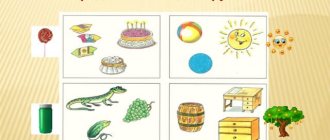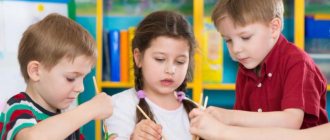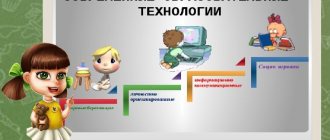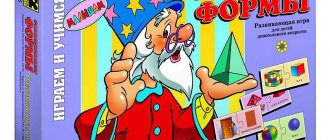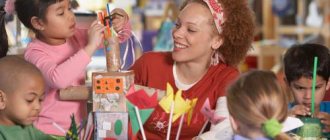Speech development in the middle group of preschool educational institutions
The development of communication and speech skills, which includes enriching vocabulary and developing clear pronunciation, is considered one of the main tasks for preschoolers.
Speech development lesson
Note! For the correct speech development of children in the middle group, educators do a tremendous amount of work. It is based on a set of special exercises and methodological techniques aimed at improving speech skills and developing a high culture and politeness of speech.
To develop speech in the middle group of preschool educational institutions, various directions are used:
- children’s knowledge and ideas about surrounding objects deepen;
- children become familiar with the details and names of parts of things;
- words denoting the properties of objects and phenomena are studied;
- vocabulary in the field of professions is replenished;
- words that denote relationships between people are studied;
- children learn to express their own thoughts in complex sentences that are grammatically correct.
To solve the assigned tasks in the middle group, the teacher must take a responsible approach to the process and purposefully conduct classes.
Federal State Educational Standards requirements for speech development
All educational institutions, regardless of whether they are public or private, must focus on certain program requirements that are specified in the Federal State Educational Standard.
As for the speech development of preschoolers, the requirements are as follows:
- Vocabulary must be constantly enriched;
- the child must have speech skills in accordance with age;
- the sound and intonation range of speech expressiveness should expand;
- develop the ability to perceive sounds by ear and at the same time hear, identify and, if there are errors, correct them;
- develop the ability to listen and remember the storyline;
- develop logically consistent and meaningful speech;
- skills of retelling and acting out dialogues;
- the child must learn to convey the meaning emotionally and read a poem by heart with expressiveness;
- work should be carried out to expand the horizons of preschoolers about objects, properties, phenomena and the concept of a coordinate system;
- generalizing concepts are introduced into the lexicon;
- training is provided to improve the grammatical construction of sentences.
Note! All training sessions should be conducted by the teacher so that they simultaneously include solving assigned problems and game moments. Only in this case will it be possible to interest children and achieve the desired results.
Directions of speech development (FSES DO)
Age-related psychological characteristics of children in the middle group of preschool educational institutions
In terms of development, middle preschool age is a continuation of early childhood. During this period, children master the world of permanent things, master the culture of speech, and the formation and development of psychological perception also occurs.
In middle age, children continue to actively develop speech, substitution ability, thinking and imagination. With the help of speech, middle group students express their emotions and share their impressions.
Note! There is a rapid development of memorizing information and retaining it in memory, and the ability to concentrate is also enhanced.
As a rule, at this age, kindergarten teachers conduct special planned classes on speech development. They are provided for by special educational standards. But, despite this, pedagogical work in this direction is not limited to a certain framework. The most important thing is that when selecting tools, the teacher must take into account all the age characteristics of his students.
Speech therapy rhythms for children with speech disorders
Methodological tools
Within the framework of the requirements of speech development, the teacher faces serious tasks that force him to approach the process thoughtfully, responsibly and in accordance with certain standards.
Basic pedagogical techniques
Each lesson on speech development in the middle group should be based on a specific pedagogical technique. Currently, three main groups of speech development techniques in preschool institutions have been identified. These are verbal, visual and playful techniques.
Their essence is as follows:
- Teaching stories using story pictures.
- Daily reading of fiction, which is provided for in the educational program.
- Carrying out work with children in a conversation format.
- Application of gaming technologies.
- Systematic and unobtrusive repetition of a new word.
- Motivation to complete the curriculum.
Note! In addition to implementing the pedagogical techniques listed above, the teacher must organize physical education sessions for students. They are also part of the curriculum and help to develop a serious attitude towards physical education in children.
Games for speech development
By the age of five, children should learn to pronounce all sounds correctly. You can achieve your goal through daily breathing exercises.
Didactic games on “Speech Development”
You can form grammatically correct speech thanks to games and exercises:
- "More less".
- “Call me kindly.”
- “Whose toy?”
- “Continue the sentence.”
- "Which".
Speech corner equipment
In order to stimulate independence and informal playful communication with children, in accordance with the requirements of the Federal State Educational Standard, an aesthetically attractive, comfortable and special subject-development environment must be created in which children will not be afraid, but rather feel at ease and at ease.
Important! It is best to place the speech corner away from the playing area in a well-lit place. It must be equipped with didactic and visual aids, as well as the necessary materials that are used by the teacher during classes.
Speech corner
Table: filling out the speech corner by section
| Chapter | Content |
| Certificate | Schemes of words, sentences and corresponding games (“Add a word”, “Choose a word”), puzzles and crosswords. |
| Connected speech | Subject pictures, “Playing in the profession”, “Guess by the description”. |
| Grammar | Games “Name it affectionately”, “One-many”. |
| Vocabulary | Pictures, lotto, puzzles. |
| Sound pronunciation | Game exercises, games to automate sounds. |
| Breath | Pipes, bubbles, balloons for inflation. |
| Fine motor skills | Pencils, puzzles, mosaics, tops. |
| Phonetic hearing | Sound differentiation games. |
| Articulation gymnastics | Pictures, sets of exercises, methodological literature. |
| Higher mental functions | Dominoes, cut pictures. |
Note! Among other things, experts recommend having Ushakova’s book “Speech Development” in the speech corner. It examines in detail all the problems of speech development for children in the middle group, selects methodological recommendations and compiles lesson notes.
Summary of a lesson on speech development in the middle group
GCD for speech development in the “Forest Parcel” middle group
Description of work: Summary of direct educational activities for children in the “Forest Parcel” middle group. The material will be useful to teachers of preschool groups. This is a summary of an educational lesson for preschoolers 4-5 years old, aimed at generalizing and consolidating the topic “Wild Animals”. Goal: Expanding vocabulary and consolidating knowledge of the names of wild animals in preschoolers. Objectives: 1. Consolidate in speech the names of wild animals and their cubs, body parts, and dwellings. 2. Development of thinking based on descriptive riddles. 3. Consolidating the ability to compose a story using mnemonic tables. 4. Development of fine motor skills of the fingers. Integration of educational areas: “Cognition”, “Communication”, “Artistic creativity”, “Socialization”, “Reading fiction”. Materials for work: - parcel with locks, letter; — cards depicting the homes of wild animals; — didactic game: “Whose tail? ”; — subject pictures depicting wild animals and their young. Preliminary work: Acquaintance with wild animals in classes on familiarization with the surrounding world, through outdoor games, imitation of animal movements.
Carrying out finger exercises, guessing and inventing riddles. GCD progress
Educator: Good morning, guys. This morning a package and a letter were brought to our group. Let's read the letter. Hello guys! We are sending you a parcel with gifts for you. But in order to open it and find out who it is from, you need to pass tests. For each test you pass, you will receive a key to the lock. We wish you good luck! Educator: Well, guys, are you ready for the test? (children's answers) Educator : In order to learn to speak beautifully and correctly, you and I need to do a warm-up for the tongue. 1. “Smile”, “Fence” Our lips smiled and went straight to our ears. You try, say “E-and-and”, show me your little fence. 2. “Pipe” A baby elephant came to visit us, Amazing child, Look at the baby elephant, Pull his lips with his proboscis. 3. “Smile” / “Tube” If our lips smile, Look - a fence appears. Well, if the sponges are a narrow tube, then we can play the pipe. 4. “Clock” One after another, one after another The arrows move in a circle. You lick both lips, show how the arrows move. 5. “Pendulum” The pendulum moves in the clock: To the left - tick, and to the right - tick. Can you do this: Tick and so, tick and so? 6. “Swing” Tanya and Nikita sat on the funny swing. The swing went down and then flew up. They probably wanted to fly away with the birds. Educator: Well done, you did the warm-up well. So, the 1st test is guessing riddles (if the answer is correct, an image of an animal is displayed). What kind of forest animal is this? Stood up like a column under a pine tree? And stands among the grass - Ears larger than head. Answer: hare Who is cold in autumn. Walking around gloomy and hungry? (Wolf) This nice red woman, Lush tail, white belly, Very scary cunning, Counts chickens in a cage, And scares the owners, Instantly runs away and straight into the forest. Answer (fox) He sleeps in a hole during the long winter, But as soon as the sun begins to warm up, He sets off on his journey for honey and raspberries... Answer (Bear) I wear a fluffy fur coat, I live in a dense forest. In a hollow on an old oak tree I gnaw nuts. Answer (Belka) Well done guys. All the riddles were solved. Here is the first key to the lock. Tell me, what animals did we guess riddles about? (children's answers). Why are they called that? (children's answers). That's right, wild animals live in the forest, and each has its own house. The next test is called “Who lives where?” On the tables there are cards with images of an animal and a home. Children are asked to connect the animal and its home with a line. When completing the task, the teacher asks related questions: Where does the wolf live? (In the den) Where does the squirrel live? (In a hollow.) Where does the fox live? (In holes.) Where does the hare live? (Under a bush.) Educator: Excellent, and we passed this test. Here is the second key to the lock. And our next test is called “Name it correctly.” The child chooses a picture from the series “animals and their cubs” and names: Fox - fox - fox cub (fox cubs) Wolf - she-wolf - wolf cub (cubs) Bear - she-bear - bear cub (cubs) Hare - hare - little hare (babies) Squirrel - squirrel - little squirrel (baby squirrels) Educator : Well done. And for this we get another key. Now I suggest you rest a little. (physical minute) Mischievous animals. The bunny jumps through the bushes, through the swamp and over the hummocks. The squirrel jumps on the branches, the mushroom is carried to the baby squirrels. The bear walks with club feet and has crooked paws. Without paths, without paths The prickly hedgehog rolls. They jump on two legs, making “ears” from their palms. They jump with their arms bent in front of their chest. They waddle. Move in a half squat, making round backs. Educator: You and I had a rest, but there is still a test, and it’s called “Make a story.” The child is asked to choose an image of one animal and use a mnemonic table to compose a story. The children's answers are heard. Educator: Another test is over, and we have another key. The last test left is “Whose tail?” On the tables are pictures of animals without tails. The child is asked to find the desired tail and glue it on, while naming whose tail it is (fox, wolf, squirrel, hare). Educator: Guys, all the tests have been passed, let's see what's inside the parcel (they open it, there's a treat). Educator: Who do you think sent you the package? (children's answers). That's right, the forest dwellers sent you gifts. Treats are given to the children.
We recommend watching:
Summary of GCD in the middle group “Mushroom Glade” Summary of GCD. My city Zheleznogorsk Summary of GCD in the middle group with elements of experimentation Integrated GCD for speech development and artistic creativity in the middle group
Similar articles:
Lesson summary for the middle group: Safety at home
Summary of a lesson in kindergarten “Receiving guests.” Middle group
Lesson summary for the middle group on the topic: Properties of glass
Lesson in the middle group of kindergarten. Village courtyard
Summary of a lesson on cognitive development in the senior group. Rules of conduct in the circus
Lesson on speech development in the middle group
Planning lessons should be carried out according to methodological recommendations.
Lessons on fairy tales
Lesson structure
Each lesson should be conducted according to a specific scheme:
- The organizational introductory part is characterized by a motivating and stimulating nature. The main task of the teacher at this stage is to get the children into the mood for work and awaken their interest in the topic.
- Practical part - the teacher sets the tasks and explains the essence of the task.
- Active work - children complete tasks in conjunction with a verbal assessment of the students’ activities.
- Summing up - the teacher’s goal is to draw children’s attention to the result.
Automation of sound C
Long-term planning for speech development in the middle group
Tsareva Maria
Long-term planning for speech development in the middle group
References:
1. V. V. Gerbova “Classes on speech development in kindergarten ”
.
2. T. R. Kislova “On the road to the ABC”
, parts 1 and 2. Moscow
“Balass”
, 2007.
3. M. A. Vasilyeva, V. V. Gerbova “Complex classes in the middle group of d/s ”
.
“Teacher”
, 2010, Volgograd.
4. N. F. Vinogradova “Stories-mysteries about nature”
.
"Ventana-Count"
, 2007.
5. N. V. Novotortseva “Teaching literacy”
.
"Academy, k."
,1999.
6. T. A. Torygina “What months of the year?”
,
speech development in kindergarten .
Moscow, 2000. town. Pristan-Przhevalsk
2016-2021 academic year G.
September
Meet our heroes. "Toys"
GOAL: To teach children to write descriptions of toys. Develop cultural communication skills, activate vocabulary; use antonyms, the plural form of the genitive case of nouns. To develop the ability to examine objects, highlighting their characteristics, qualities and actions. To develop the ability to write a descriptive story about toys together with the teacher. Establish rules for handling toys. Develop focus .
Learning by heart: “Ball”
S. Ya. Marshak
GOAL: To help children remember and read the poem expressively; practice speech breathing (pronouncing the sound w on one exhalation)
; develop dramatization skills. Exercise children in using verbs with prefixes.
"Fruits vegetables"
GOAL: To introduce the name of vegetables and the place where they are grown; learn to describe vegetables; solve riddles; practice using diminutive words, as well as using plural nouns.
Introduce children to the name of fruits, teach them to describe fruits, compare; solve riddles, agree on definitions and nouns;
develop speech . Enrich children’s knowledge about how people store fruits and vegetables, how they prepare food for the winter; activate the dictionary; develop coherent speech .
“Reading poems about late autumn”
GOAL: To introduce children to poetry. Help memorize passages of poems.
Speech development classes "
V. V. Gerbova p. 37
Learning the nursery rhyme “Pussy”
GOAL: To teach to help children remember the nursery rhyme and pronounce it expressively.
Speech development classes "
V. V. Gerbova p. 29
Reading the fairy tale “Telephone”
GOAL: To please children by reading a fairy tale. Practice dramatizing excerpts from the work.
Speech development classes "
V. V. Gerbova p. 30
"Retelling of the fairy tale "Turnip"
GOAL: To form an idea of what a folk tale is. To develop the ability to retell a familiar fairy tale together, in a “chain”
.
Develop attention and memory.
Develop the ability to listen to each other, carefully follow the story. Retelling of the fairy tale "Teremok"
GOAL: To form an understanding of such a feature of folk tales as observation. Develop the ability to retell a familiar fairy tale using models. the character’s appearance . Exercise the ability to solve riddles, relying on the visual image of animals, and justify your answer.
October
"Autumn"
GOAL: To consolidate knowledge about the autumn months, about the signs of autumn. Develop attention , creativity, and the ability to solve riddles; develop correct speech .
Narration based on the painting “Autumn Day”
Practice purposefully examining the plot picture and answering questions about its content.
Learning the Russian folk song “Shadow-tenpoteteten”
GOAL: To help children remember and read the song expressively.
Speech development classes "
V. V. Gerbova p. 32
"Vegetables and fruits. “What did autumn give us?”
.
GOAL: Making riddles about vegetables and fruits.” Expand children's understanding of vegetables and fruits, teach them to group objects , name vegetables and fruits, and note their quality characteristics.
“A story from personal experience on the topic “My Pets”
GOAL: Storytelling based on the painting “Dog with Puppies”
Learn to talk about a topic from personal experience suggested by the teacher. Learn to correctly name animals and their body parts. Continue working to deepen knowledge about animals. 2. Learn to describe a picture in a certain sequence.
Speech development classes "
V. V. Gerbova p. 37
A story from personal experience on the topic “My native land”
GOAL: 1. 1. Learn to name your native village, street. 2. Learn to name the street on which the kindergarten is located. 3. Introduce you to the sights of your native land. 4. Cultivate pride and love for one’s native village.
Speech development classes "
V. V. Gerbova p. 33
"House"
GOAL: To introduce different houses, learn to describe houses; practice using plural nouns.
Sound culture of speech : sounds “z”
from
*"
.
PURPOSE: To train children in the pronunciation of the isolated sound “z”
(in words, syllables)
;
learn to pronounce the sound “z”
firmly and softly;
distinguish between words with the sound “z”
and
“z*”
.
Speech development classes "
V. V. Gerbova p. 31
"Change in Nature in October"
GOAL: Learn to talk about changes in nature in October, describe nature in October; agree on nouns and definitions.
"Forest in Autumn"
GOAL: Did. Exercise “How many words in a sentence”
Help children perceive a poetic description of autumn nature;
form a basic idea of the proposal; activate the dictionary. Learning by heart: A. Pleshcheev “In Autumn”
Learn to characterize the signs of deep autumn when looking at paintings and illustrations, recognize these signs in poems; help memorize A. Pleshcheev’s poem and read it expressively.
November
"Furniture"
GOAL: To practice using the pronouns MY, MY, as well as words in the plural; introduce the name of furniture and its components; learn to compare individual pieces of furniture, describe furniture
"Family"
GOAL: To introduce different houses, learn to describe houses; practice using plural nouns.
"Dishes"
Sound culture
of speech : sound “C”
GOAL: 1. To consolidate the general concept: tableware. Introduce the classification of tableware: kitchen, dining room, tea. Reinforce table manners.
2. Exercise children in pronouncing the sound “Ts”
isolated, in syllables, in words.
“Classes on
speech development ” by V.V. Gerbova p. 35
"Cloth"
GOAL: Learn to describe items of clothing, select clothes according to the season. Improve verbal communication skills; enrich your understanding of the environment.
"Beasts"
GOAL: To enrich children's knowledge about wild animals. To consolidate knowledge about the habitat of wild animals;
"Pets"
GOAL: To practice using plural nouns, to learn to compare animals, to describe them; develop children's speech
Reading the Russian folk tale “The Little Fox and the Gray Wolf”
GOAL: To introduce children to a Russian folk tale (model by M. Bulatov, to help evaluate the actions of the heroes, to dramatize an excerpt from the work.
Speech development classes "
V. V. Gerbova p. 42
Game - initiation “We have a visiting bear”
GOAL: To teach children to notice the presence of a stranger a group
Speech development classes » V. V. Gerbova p. 60
December
"Winter"
PURPOSE: To clarify and generalize children’s understanding of winter and the winter months. Reinforce knowledge about the signs of winter. Improve verbal communication skills
Storytelling based on the painting “Winter Fun ”
Learn coherent
speech , use complex sentences, describe changes in nature in winter.
Learning by heart: I. Surikov “Winter
GOAL: To help feel the beauty and lyricism of I. Surikov’s work. Learn to read a poem by heart expressively.
“Composing a narrative story “Masha’s Adventure in the Forest”
.
GOAL: To develop the ability to compose a joint narrative story using the utterance scheme specified by the teacher. Develop the ability to adhere to the plot line when composing a story. Practice selecting signs for an animal, as well as selecting verbs that denote the characteristic actions of animals. Develop a sense of humor .
Christmas tree" K. Chukovsky
GOAL: To help comprehend and memorize a new poem; practice intonation expressiveness of speech .
Narration based on the plot picture “Winter”
GOAL: Reading and memorizing a poem about winter. Learn to compose sentences based on a plot picture, coordinate words in a sentence, determine and name the location of an object (left, right, next to, around, between, time of day, characterize the mood and state of people. Introduce children to poetry.
Help you remember and read poems expressively.
Speech development classes "
V. V. Gerbova pp. 43, 45
Reading and memorizing Pleshcheev’s poem about winter “White fluffy snow...”
.GOAL: To introduce children to poetry. Help you remember and read the poem expressively.
Speech development classes "
V. V. Gerbova p. 43
Reading the Russian folk tale “Zimovye”
.
GOAL: To help children remember Russian folk tales they know. Introduce the fairy tale “Wintermovie”
Speech development classes "
Sokolov-Mikitov) V.V. Gerbova p. 47
Teaching storytelling based on the painting “Tanya is not afraid of the frost”
GOAL: To teach to look at a picture and talk about it in a certain sequence; learn to come up with a title for a painting.
Speech development classes "
V. V. Gerbova p. 50
January
Compiling a story based on the picture “In the Forest”
PURPOSE: To help examine and describe the picture in a certain sequence. Continue learning to come up with a title for the painting.
Speech development classes "
V. V. Gerbova p. 55
Sound culture of speech : the sound “SH”
.
GOAL: Show children the articulation of the sound “SH”
, teach to clearly pronounce a sound in isolation, in syllables, in words.
Speech development classes "
V. V. Gerbova p.
Sound culture of speech : the sound “Zh”
.
GOAL: Reading your favorite poems. memorizing the poem by A. Barto “I know what I need to come up with”
.
Practice correct and clear pronunciation of the sound “F”
isolated in onomatopoeic words;
the ability to identify words with the sound “Zh”
Speech development classes ”
V. V. Gerbova pp. 48, 51
Sound culture of speech : the sound “Ch”
PURPOSE: Explain how to correctly pronounce the sound “CH”
, practice pronouncing sounds in isolation, in words, in poetry.
Speech development classes "
V. V. Gerbova p. 53
"Animals of hot countries"
.GOAL: To give an idea of the animals of hot countries. Activate children's vocabulary.
Birds"
GOAL: Learn to describe poultry; introduce antonyms; to enhance children's knowledge about the appearance of poultry and their habits. Cultivate interest and love for birds
Mini-quiz based on the fairy tales of K. Chukovsky. Reading the work “Fedorino’s grief”
PURPOSE: To help remember the names and contents of K. Chukovsky’s fairy tales. Introduce the fairy tale “Fedorino’s grief”
.
Speech development classes "
V. V. Gerbova p. 52
February
"Fish"
GOAL: To introduce children to fish and their habitat ; learn to solve riddles;
practice using plural nouns.
"Bread products"
GOAL: To introduce children to products made from flour; learn to describe one product; develop speech
"Dairy products"
GOAL: To introduce dairy products and their benefits to the body; practice using plural nouns.
"Transport"
GOAL: To clarify children's knowledge about vehicles , to expand their vocabulary with the names of cars. Introduce words with the same root. To develop the ability to examine objects, highlighting their characteristics, qualities and actions. Develop the ability to write a descriptive story together with the teacher. Introduce children to water transport and activate the corresponding words in speech . Strengthen the ability to combine objects into pairs based on material. Introduce air transport, their components, describe them; practice using plural nouns, develop speech .
March
"Spring"
GOAL: To teach to describe spring, to provide knowledge about seasonal changes associated with the first months of spring; practice using plural nouns.
Getting ready to celebrate spring and International Women's Day
GOAL: To introduce children to A. Pleshcheev’s poem “Spring”
. Practice your ability to congratulate on the holiday.
Speech development classes "
V. V. Gerbova p. 59
"Traffic Laws. Traffic light"
PURPOSE: To introduce the designation of road signs and traffic lights; develop speech ; activate children's vocabulary.
"Theatre, musical instruments"
GOAL: To introduce theater and musical instruments. Continue teaching children to divide words into parts.
"Sport"
GOAL: To introduce various sports; develop children's speech ; Continue to introduce words with the same root; activate children's vocabulary.
Sound culture of speech : the sound “Shch-Ch”
GOAL: To practice correctly pronouncing the sound “Ш”
and differentiation of the sounds
“Ш”
and
“Ч”
.
Speech development classes "
V. V. Gerbova p. 60
Compiling stories based on paintings
PURPOSE: To check whether children can adhere to a certain sequence when composing a story based on a picture; did they understand what it meant to title a picture? Speech development classes "
V. V. Gerbova p. 62
Reading the fairy tale by D. Mamin-Sibiryak “The Tale about Komar Komarovich - Long Nose and about Hairy Misha - Short Tail”
GOAL: To introduce children to the author's literary fairy tale. Help them understand why the author calls the mosquito so respectfully.
Speech development classes "
V. V. Gerbova p. 63
April
"Kindergarten"
GOAL: To form children’s understanding of kindergarten employees; labor processes performed by each of them; cultivate respect for the work of adults; practice using plural nouns, develop speech
"Professions"
GOAL: To teach children to answer the teacher’s questions with a complete answer; enrich and clarify children’s understanding of adult professions; learn to guess riddles about professions; cultivate respect for the work of adults; activate children's vocabulary.
"Forest. Trees. "Fruits, seeds."
GOAL: To introduce the name of some trees, the components of a tree, the benefits of trees; solve riddles; activate children's vocabulary, teach to describe berries; introduce the fruits of trees and shrubs;
"Houseplants"
PURPOSE: To introduce the name of indoor plants and how to care for them; learn to describe indoor plants
Sound culture of speech : sound “L-L*”
GOAL: To train children to clearly pronounce the sound “L”
in sound combinations, words, phrasal
speech . Improve phonemic awareness - learn to identify words with the sounds “L-L*”
Speech development classes ”
V. V. Gerbova p. 63
Teaching storytelling: working with a matrix picture and handout pictures.
GOAL: Learn to create a picture and talk about its content. Develop creative thinking .
Speech development classes "
V. V. Gerbova p. 65
Memorizing the poem by Yu Kushak “Olennok”
Learning the Russian folk song
“Grandfather wanted to cook fish soup”
GOAL: To help children remember and read the poem expressively.
Speech development classes "
V. V. Gerbova p. 66
May
"Victory Day. Military equipment"
PURPOSE: To give an idea of the Victory Day holiday; learn to talk, answer questions; develop children's speech .
Sound culture of speech : sound “R, R*”
GOAL: To train children to clearly and correctly pronounce the sound “R”
isolated, in pure language, in words.
Speech development classes "
V. V. Gerbova p. 69
"Insects"
GOAL: To introduce the name of insects, their characteristics; use plural nouns.
"Summer"
PURPOSE: To introduce seasonal changes in nature in summer. Learn to describe a summer day; activate children's vocabulary.
"Berries"
GOAL: To introduce the name of the berries; learn to compare berries by color, size; practice using plural nouns.


